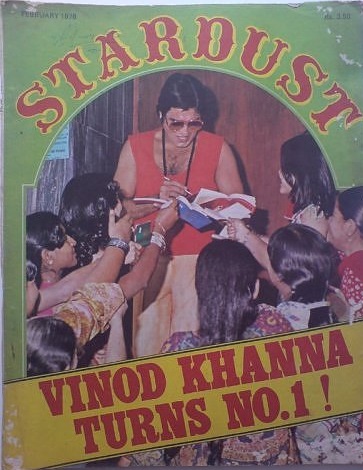Stardust
This is a collection of articles archived for the excellence of their content. |
Stardust was...
... for most of the 1970s and 1980s India's highest selling English-language magazine about the artistes of Hindu-Urdu cinema.
Rise to the top
Stardust acquired a huge circulation by printing gossip, which its high-minded rival Filmfare, no.1 in English till then, stayed miles away from (and continued to do so for years, till its relevance other than for handing out annual awards was at stake). Stardust entered a space thitherto occupied by cheap but hugely successful Hindi and Urdu film rags.
Trying to damage Amitabh Bachchan’s career

In 1974-75 Amitabh Bachchan's career had finally begun to take off, after years of frustration and struggle, while Stardust, edited by Mrs Shobha Kilachand (later, Mrs Shobhaa De), was India's biggest-selling English-language film magazine—because it printed gossip, some of it blatantly and deliberately untrue. Stardust was not above abusing the power that its huge circulation gave it.
Example: In order to spite and harm Mr Amitabh Bachchan, who had by then become the no. 1 actor in North India (and, arguably, India), and remained so for the next sixteen years, Stardust printed a COVER story claiming that actor Vinod Khanna had turned no.1. Poor Mr Khanna must have been embarrassed by that because he was not the highest paid or most successful actor for even one minute of his career.
To check the veracity of this claim let us look at the Hindi-Urdu hits of the three preceding years. (Readers can check the yearwise lists of hits for themselves at Hindi-Urdu cinema: 1970-79.)
1975: Sholay, which was the no.1 film of the year (and, by some accounts, of all times), Deewaar, which had been the biggest hit of the year till August, when Sholay pushed it down to no.2 and Zameer, the No. 8 hit of the year, all starred Mr Bachchan. (In Sholay Bachchan was the second lead.)
1976 Mr Bachchan was the main star of Hera Pheri, which was the No. 2 hit of the year (after the Manoj Kumar starrer Dus Numbri), Kabhi Kabhie, which was No.6, and Do Anjaane, which was No. 9. Mr Vinod Khanna was the second lead of Hera Pheri.
1977 Mr Bachchan was the main lead of Amar Akbar Anthony (No.1), Parvarish (No. 4) and Khoon Pasina (No.10). All three featured Mr Vinod Khanna in the second lead. On paper Dharmendra’s position at the top remained intact in all of 1975 and 1976, though with hindsight we know that Amitabh Bachchan had become the no.1 star by late 1975. It was with Amar Akbar Anthony that Amitabh Bachchan was officially accepted as the country’s no.1. (The Rajinikanth phenomenon had not engulfed the country by then.)
1978 The four biggest hits of the year (and no. 7) all starred Mr Bachchan. Or, to put it another way, all five Bachchan films released that year were in the top 7. The biggest hit of the year Muqaddar Ka Sikandar had a brilliant performance by Mr Vinod Khanna in the second lead.
With hindsight Amitabh Bachchan’s reign at the top seems to have lasted from 1975 to early 1992. However, as stated above, that he had formally dethroned Dharmendra from the top spot was not obvious till the mid-1977.
Today the February 1978 cover of Stardust, which claimed that Vinod Khanna had turned No.1, appears to be a piece of cheap and vicious abuse of journalistic power, which it was. Today people see re-runs of Bachchan- Vinod Khanna films for Amitabh Bachchan and not for Vinod Khanna. However, in February 1978 Amitabh Bachchan had been the undisputed no.1 for barely one year (as mentioned, in 1975 and 1976 he shared that space with Dharmendra, with some Rishi Kapoor films not far behind)
In February 1978 if India's biggest-selling English-language film magazine said that Vinod Khanna had turned No.1, at least some readers initially believed this to be true, till they went to the cinemas and saw that Amitabh Bachchan was rocking even bigger than before. Instead of causing damage to Amitabh Bachchan’s career, as it intended to, the cover story shattered Stardust’s own credibility.
For years Stardust did not carry articles about Amitabh Bachchan, Jaya Bhaduri (later Mrs. Bachchan), Dilp Kumar (another legend), his wife Saira Bano and one more star, in the belief that if India's biggest selling English-language film magazine did not give them publicity their careers would be hurt.
That was what many others in the media, drunk with notions about The Power of the Press, also assumed. But it was during Stardust's boycott of him that Mr. Bachchan rose to become no.1 (and stayed there from mid-1975 to early 1992), proving the irrelevance of the media in promoting or destroying careers. It was Stardust whose credibility was shattered and whose sales suffered somewhat. Stardust swallowed humble pie when Amitabh Bachchan met with a near-fatal accident in 1982.
To find out how, forty years later in 2016, Mr Bachchan devastated Shobhaa ji in a tweet, without even naming her, see The Olympics: India (2016)> Media skirmishes back home in India> Granny’s ageing foot in ageing mouth.
